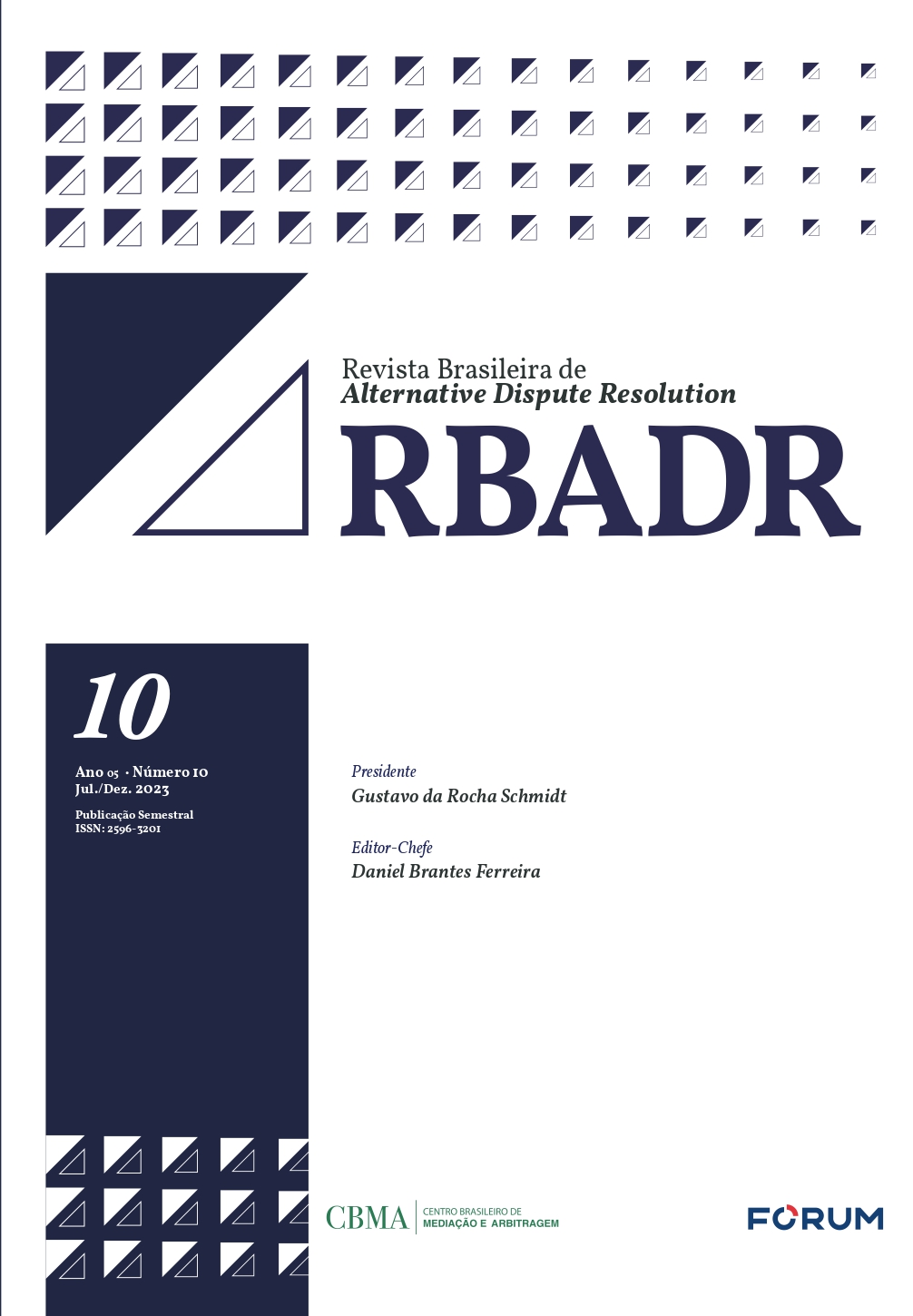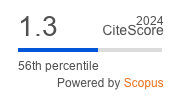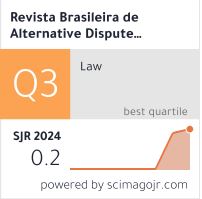Unleashing Alternative Dispute Resolution (ADR) in Resolving Complex Legal-Technical Issues Arising in Cyberspace Lensing E-Commerce and Intellectual Property
Proliferation of E-Commerce Digital Economy
Schlagworte:
ADR, Cyberspace, Digital Economy, IPR, Legal-Technical AspectsAbstract
The rapid growth of cyberspace has brought about numerous legal and technical challenges, often requiring innovative solutions for effective dispute resolution. The exponential growth of the digital era has ushered in a dynamic landscape known as cyberspace, replete with intricate legal and technical challenges. As online interactions, transactions, and intellectual property rights become increasingly prevalent, so too do the disputes and conflicts that arise within this virtual realm. Navigating these multifaceted complexities requires innovative approaches to dispute resolution that transcend traditional legal paradigms. Alternative Dispute Resolution (ADR) emerges as a compelling solution in this context, offering a versatile toolkit for resolving disputes that meld intricate legal considerations with complex technological dimensions. Cyberspace, characterized by its global connectivity and rapid evolution, spans a spectrum of activities from e-commerce transactions to the protection of intellectual property rights. The intricacies embedded within these digital interactions often transcend geographical boundaries, rendering traditional litigation processes cumbersome, time-consuming, and expensive. This is particularly evident when confronting disputes that intertwine legal issues with intricate technical aspects, necessitating expertise that straddles the domains of law and technology. ADR, with its diverse range of methods such as mediation, arbitration, and negotiation, presents a nimble alternative that aligns with the dynamic nature of cyberspace while catering to the specific demands of these complex disputes. Through the lens of real-world case studies, prevailing legal frameworks, and practical considerations, we delve into the symbiotic relationship between ADR and cyberspace, unraveling the pivotal role ADR plays in efficiently addressing complex disputes while fostering an environment conducive to innovation and equitable resolutions. As it traverse the terrain of alternative dispute resolution in the digital landscape, it seek to illuminate the ways in which ADR serves as a lighthouse, guiding parties through the tumultuous waters of legal-technical disputes in cyberspace. By probing the depths of its methodologies, exploring its advantages and limitations, and addressing the integration of technical expertise into the dispute resolution process, we pave the way for an in-depth understanding of how ADR not only bridges the gap between law and technology but also propels the evolution of dispute resolution mechanisms in the ever-evolving realm of cyberspace. The paper explores the applicability of ADR methods, such as mediation, arbitration, and negotiation, to navigate complex disputes in online environments, focusing on e-commerce and intellectual property realms. By analyzing case studies, legal frameworks, and practical implications, this paper highlights the benefits and challenges of employing ADR to resolve intricate disputes arising in the digital landscape.
Literaturhinweise
Cometti, A. K. F., & Moschen, V. R. B. The Singapore Convention in the Framework of the InvestorState Dispute Settlement System. Revista Brasileira de Alternative Dispute Resolution - RBADR, vol. 4, n. 7, p. 37-57, 2022.
Lide, E. C. (1996). ADR and cyberspace: the role of alternative dispute resolution in online commerce, intellectual property and defamation. Ohio St. J. on Disp. Resol., 12, 193.
Yaroshenko, O., Moskalenko, O., Sereda, O., Inshyn, M., & Burniagina, Y. The Role of Trade Unions as a Subject of Social Partnership in Resolving Labour Disputes. Revista Brasileira de Alternative Dispute Resolution - RBADR, vol. 4, n. 7, p. 147-161, 2022.
Perritt Jr, H. H. (1999). Dispute resolution in cyberspace: Demand for new forms of ADR. Ohio St. J. on Disp. Resol., 15, 675.
Turner, R. I. (2000). Alternative Dispute Resolution in Cyberspace: There is More on the Line, Than Just Getting” Online”. ILSA J. Int’l & Comp. L., 7, 133.
Derevyanko, B., Selikhov, D., Armash, N., Severinova, O., & Orlova, I. Alternative ways of resolving shareholder disputes in property relations in Ukraine and the EU. Revista Brasileira de Alternative Dispute Resolution - RBADR, vol. 4, n. 7, p. 59-74, 2022.
Haloush, H. A., & Malkawi, B. H. (2008). Internet Characteristics and Online Alternative Dispute Resolution. Harv. Negot. L. Rev., 13, 327.
Haloush, H. A., & Malkawi, B. H. (2008). Internet Characteristics and Online Alternative Dispute Resolution. Harv. Negot. L. Rev., 13, 327.
Katsh, M. E. (1995). Dispute resolution in cyberspace. Conn. L. Rev., 28, 953.
Piestsov, R., Kupina, L., Karpova, N., Vyshnovetska, S., & Ustynova, I. Extrajudicial bodies for labor conflicts resolution. Revista Brasileira de Alternative Dispute Resolution - RBADR, vol. 4, n. 7, p. 201-213, 2022.
De Werra, J. (2016). Alternative Dispute Resolution in Cyberspace: The Need to Adopt Global ADR Mechanisms for Addressing the Challenges of Massive Online Micro-Justice. Swiss. Rev. Int’l & Eur. L., 26, 289.
Ware, S. J., & Cole, S. R. (1999). ADR in Cyberspace. Ohio St. J. on Disp. Resol., 15, 589.
De Werra, J. (2016). ADR in Cyberspace: The Need to Adopt Global Alternative Dispute Resolution Mechanisms for Addressing the Challenges of Massive Online Micro-Justice. Swiss Review of International & European Law, 289-306.
Teitz, L. E. (2001). Providing legal services for the middle class in cyberspace: The promise and challenge of on-line dispute resolution. Fordham L. Rev., 70, 985.
Bol, S. H. (2003). Online Dispute Resolution, Resolving Conflicts in Cyberspace.
Mitchell, R. T. (1998). Resolving Domain Name-Trademark Disputes: A New System of Alternative Dispute Resolution Is Needed in Cyberspace. Ohio St. J. on Disp. Resol., 14, 157.
Haloush, H. A. (2008). The Nature of Consent in Mandatory Schemes of Dispute Settlement in Cyberspace. Manchester J. Int’l Econ. L., 5, 70.
Lasprogata, G. A. (2001). Virtual Arbitration: Contract Law and Alternative Dispute Resolution Meet in Cyberspace. J. Legal Stud. Educ., 19, 107.
Victorio, R. M. (2000). Internet dispute resolution (iDR): bringing ADR into the 21st century. Pepp. Disp. Resol. LJ, 1, 279.
Fenwick, J. (2009). ‘See you in cyberspace!’The rise of online alternative dispute resolution. Insurance Law Journal, 20(2), 123-140.
Haloush, H. A. (2008). The Liberty of Participation in Online Alternative Dispute Resolution Schemes. International Journal of Legal Information, 36(1), 102-117.
Perritt Jr, H. H. (1999). Dispute resolution in cyberspace: Demand for new forms of ADR. Ohio St. J. on Disp. Resol., 15, 675.
Turner, R. I. (2000). Alternative Dispute Resolution in Cyberspace: There is More on the Line, Than Just Getting” Online”. ILSA J. Int’l & Comp. L., 7, 133.
Hang, L. Q. (2000). Online dispute resolution systems: The future of cyberspace law. Santa Clara L. Rev., 41, 837.
Marques, L. L., Paoliello, G. J., & Rocha, R. B. Maritime arbitration–Ad hoc and institutional methods: A view from a Brazilian perspective. Revista Brasileira de Alternative Dispute Resolution - RBADR, vol. 3, n. 6, p. 163-175, 2021.
Edwards, H. T. (1985). Alternative dispute resolution: Panacea or anathema. Harv. L. Rev., 99, 668.
Menkel-Meadow, C. (2015). Mediation, arbitration, and alternative dispute resolution (ADR). International Encyclopedia of the Social and Behavioral Sciences, Elsevier Ltd.
Carver, T. B., & Vondra, A. A. (1994). Alternative dispute resolution: Why it doesn’t work and why it does. Harvard Business Review, 72, 120-120.
Vaughn, L. B. (1998). Integrating alternative dispute resolution (ADR) into the curriculum at the University of Washington School of Law: A report and reflections. Fla. L. Rev., 50, 679.
Fiadjoe, A. (2013). Alternative dispute resolution: a developing world perspective. Routledge.
Sternlight, J. R. (2006). Is Alternative Dispute Resolution Consistent with the Rule of Law-Lessons from Abroad. DePaul L. Rev., 56, 569.
Singh, B. (2019). Profiling Public Healthcare: A Comparative Analysis Based on the Multidimensional Healthcare Management and Legal Approach. Indian Journal of Health and Medical Law, 2(2), 1-5.
Barrett, J. T., & Barrett, J. (2004). A history of alternative dispute resolution: The story of a political, social, and cultural movement.
Bandle, A. L., & Theurich, S. (2011). Alternative Dispute Resolution and Art-Law-A New Research Project of the Geneva Art-Law Centre. J. Int’l Com. L. & Tech., 6, 28.
Menkel-Meadow, C. (2018). Ethics in alternative dispute resolution: New issues, no answers from the adversary conception of lawyers’ responsibilities. In Mediation (pp. 429-476). Routledge.
Schmidt, G., Ribeiro, N., & Ferreira, D. B. The Brazilian Center for Arbitration and Mediation (CBMA) as an appellate sports arbitration institution. Revista Brasileira de Alternative Dispute Resolution - RBADR, vol. 3, n. 6, p. 93-108, 2021.
Singh, B. (2022). Relevance of Agriculture-Nutrition Linkage for Human Healthcare: A Conceptual Legal Framework of Implication and Pathways. Justice and Law Bulletin, 1(1), 44-49.
Menkel-Meadow, C. (2018). Ethics in alternative dispute resolution: New issues, no answers from the adversary conception of lawyers’ responsibilities. In Mediation (pp. 429-476). Routledge.
Cheung, S. O. (1999). Critical factors affecting the use of alternative dispute resolution processes in construction. International Journal of Project Management, 17(3), 189-194.
Blackman, S. H., & McNeill, R. M. (1997). Alternative Dispute Resolution in Commercial Intellectual Property Disputes. Am. UL Rev., 47, 1709.
Samuelson, P. (1999). Intellectual property and the digital economy: Why the anti-circumvention regulations need to be revised. Berkeley Tech. LJ, 14, 519.
Singh, B. (2023). Blockchain Technology in Renovating Healthcare: Legal and Future Perspectives. In Revolutionizing Healthcare Through Artificial Intelligence and Internet of Things Applications (pp. 177-186). IGI Global.
El-Ebiary, Y. A. B. (2021). Customer Review on Confidence, Readiness and Security in Electronic Commerce. Turkish Journal of Computer and Mathematics Education (TURCOMAT), 12(10), 6513-6518.
Kahn, A., & Wu, X. (2020). Impact of digital economy on intellectual property law. J. Pol. & L., 13, 117.
Kaufmann-Kohler, G., & Schultz, T. (2004). Online dispute resolution: challenges for contemporary justice. Kluwer Law International BV.
Mania, K. (2015). Online dispute resolution: The future of justice. International Comparative Jurisprudence, 1(1), 76-86.
Haloush, H. A., & Malkawi, B. H. (2008). Internet Characteristics and Online Alternative Dispute Resolution. Harv. Negot. L. Rev., 13, 327.
Katsh, E. (2004). Bringing online dispute resolution to virtual worlds: creating processes through code. NYL Sch. L. Rev., 49, 271.
Downloads
Veröffentlicht
Ausgabe
Rubrik
Lizenz
Copyright (c) 2023 Revista Brasileira de Alternative Dispute Resolution - Brazilian Journal of Alternative Dispute Resolution - RBADR

Dieses Werk steht unter der Lizenz Creative Commons Namensnennung 4.0 International.
No royalties or other compensation shall be due for the publication of the works.
The opinions expressed by the authors of the articles and reviews are their sole responsibility.









